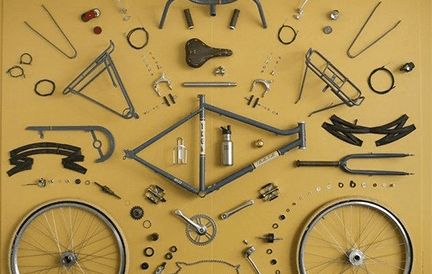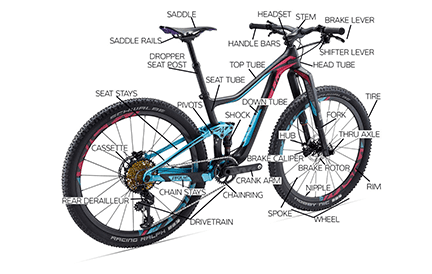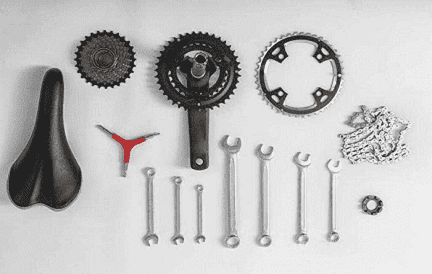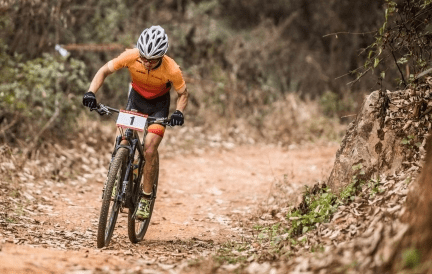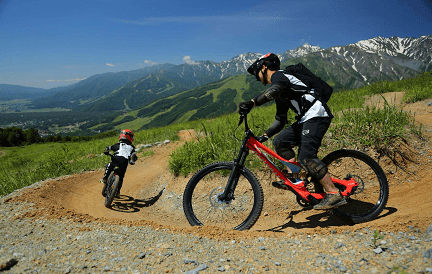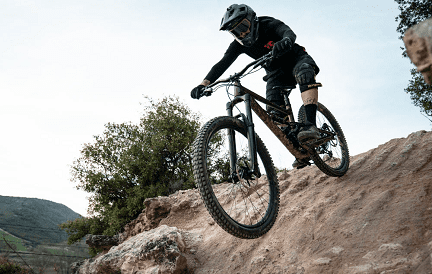Cycle suspension has at least a few advantages. Making the machine look more aggressive, it is also much more comfortable to ride and safer. Imagine that you suddenly hit a protruding root or stone during a fast descent on the trail. Such an encounter could hurt a lot if not for the cycle suspension. Why does this happen?
- Part 1: Introduction
- Part 2: Buying Guide
- Part 3: Recommendations
- Part 4: Selection Guide
- Part 5: Frequently Asked Questions
Part 1: Introduction
The first patents describing full-suspension bicycles appeared as early as the end of the 19th century. Despite appearances, the ideas of the time were not so different from those of today. The need for cushioning for both wheels was already obvious at that time. Any vehicle moving on wheels should have a suspension system. It’s not just a matter of comfort but safety.

Imagine a car with suspended front wheels, but the rear wheels are not? Its wheels bouncing off obstacles instead of passing the obstacle? There are still rigid bikes that ride off-road is only due to the higher cost of manufacturing fulls. We can highlight a few competing ideas. Not sure whether to choose a rigid or suspension fork?
This handful of information will be useful in practice, even when performing basic maintenance tasks. A visit to a specialist for maintenance or adjustment of shock absorbers will no longer be necessary. We will prepare the bike for riding ourselves.
Part 2: Buying Guide
The Role of the Shock Absorber on a Bicycle
Cycle suspension is used in models designed for varied and more difficult terrain. The case is completely different from MTB bikes. Road bikes, which are designed for riding on flat asphalt, do not need this type of support, let alone additional load. It will also come as no surprise that choosing a bike with or without a shock absorber will depend on your individual needs.
The cycling world has moved on so much that even gravel bikes, especially models designed for bikepacking, can be equipped with front suspension, which was unthinkable a few years ago. Of course, recreational trail riders have different expectations from those who compete in XC events. SR Suntour, Rock Shox, or FOX shock absorbers offer many solutions and different effects.
Without a detailed specification, we should assume that a bicycle shock absorber is responsible for traction, so it must perform two tasks.
Firstly, it springs, or in simplest terms, it flexes when the wheel encounters a bump, allowing it to smoothly overcome the obstacle.
Second, it dampens energy, allowing the mechanism to return to its original state without the effect of bouncing the steering wheel. This function, also known as rebound damping, is important because of its effect on driving stability. Its effect on the body, including the hands and arms, to which vibrations are transmitted.
Method of Vibration Damping
Vibration resorption and absorption in the case of suspension forks can take place via different media. Hence the distinction between:
spring-loaded,
elastomer-spring,
oil-air,
oil-spring.
Purpose and Stroke
Since there is no single discipline of MTB in the world, for the same reason, the types of cycle suspension and their characteristics will also be quite different. Parameters for recreational paths and trekking expeditions are not effective on a difficult trail, and vice versa. It makes sense to match the suspension to the bike’s style of riding and purpose. The greater the suspension range, the better our machine finds its way on more technical terrain and trails. So let’s take a look at the types of cycle suspension, taking into account their travel.
Cross and Trekking Bikes: 60-80 mm
In cross and trekking bikes, 60-80 mm bump damping is sufficient for small bumps. Small travel does not mean poorer performance. The cyclist’s body is relieved, and travel comfort is maintained. The idea is to be light and rather stiff, and this task is fulfilled one hundred per cent.
XC: 100-120 mm
XC is the first off-road discipline. When it comes to riding fast, it has to be light with a balance of stiffness, so 100 to 120 mm suspension works best.
Dirt, Four Cross, Street MTB: 100 mm
Dirt, Four Cross, Street MTB -mountain bike suspension parts made for these riding styles need to handle heavy loads. So they need MTB suspension at the 100mm level, as the small travel helps keep the heavy and powerful machine stable during jumps and landings.
Trail: 120-150 mm
In trail, 120-150 mm of MTB suspension travel is quite common. It absorbs big shocks, and its versatility will find its way on both challenging and lighter enduro trails and the most interesting trails in the area. The cushioning allows you to polish your off-road skills in the name of fast descents.
All Mountain: 130-160 mm
All-mountain riding can benefit from a slightly wider suspension range. A 130-160 mm is the right size, offering a balance of speed and stability. If you’re a rider who gets off the ground, climbs like a powerlifter, and competes in enduro events, this range of suspension is the right choice.
Enduro: 150-180 mm
On enduro bikes, travel in the 150-180 mm range allows you to go to the bike park and DH and enduro competitions. If you do a lot of jumping and riding uphill and push your machine a lot, a suspension with this kind of travel certainly comes in handy.
FreeRide/DH: 180-200+
The 180-200+ mm of shock travel is the longest of all available. Where does it work best? Firstly, in FreeRide, extreme discipline consists of soaring, jumping, and overcoming obstacles as efficiently. Secondly, in DH, the quintessence of which is descending steep mountain slopes.
Bicycle Shock Design – Unusual Designs
Among the divisions into types of bicycle shocks, there is also one that considers their different designs. The simplest front cycle suspension consists of the following components: steering tube, fork crown, adjusters, upper and lower shanks, compression medium, and damping medium. On top of that, of course, some parts allow for wheel mounting and brake mounts.
The most popular is the telescopic construction characterized by the presence of two tubes – shins. The upper one slides into the lower one when we overcome bumpy terrain. Two- or three-shelf. Their constructions are very specific, and we can recognize them by their appearance alone. The shelves are used for stiffening and connecting the shins.
Bicycle suspension upside down is found in downhill bicycles. These models work opposite to the telescopic version, i.e., the lower legs go into the upper legs. Resorbing can also take place in the fork steering tube. Cannondale is famous for such a solution. It allows to reduce the weight of the bicycle suspension and maintain greater stiffness. Pantograph suspension features a separate damping element – the pantograph – located outside the structure. Such models are resistant to torsional forces, offering adequate stiffness.
If you see a bike with a single knuckle tube, it doesn’t mean it’s incomplete. The so-called lefty cushioning really exists. Cannondale has been developing this technology for years.
Rigid axle suspension requires wheels with special hubs.
Part 3: Recommendations
Bike Shock Absorber Types
The whole problem is in the details. Let’s look at the basic divisions of bicycle suspension, solving many technical conundrums.
Front and Rear, or Suspension Fork and Damper
Full suspension is the hallmark of full-suspension bikes. The presence of dual-suspension is unique – classic at the front in the fork and at the rear in the form of a damper. It is useful for off-road cycling varieties such as trail, enduro, or downhill, where the quintessence of these disciplines is riding over uneven ground. Mountain and forest paths are strewn with rocks, protruding roots, and high hills and drops, which are the Element of Fuller.
Constant work of the damper and suspension fork in the field is invaluable. Both elements are responsible for damping any shocks and forces hitting obstacles, so a bike with a two-cycle suspension allows you to do the impossible in quite comfortable conditions.
In difficult terrain, the reliability of the rear suspension contributes to efficient and confident pedalling. It is possible to maintain higher speed on descents or ascents when a bumpy surface is under the wheels. The damper also helps minimize lower back pain caused by absorbing impacts with obstacles. On the other hand, a suspension fork contributes to the bike’s manoeuvrability and better traction, especially by keeping the front wheel steady on the ground. Give your wrists time to rest and less stress on your joints.
Part 4: Selection Guide
Rear Swingarms
The rear wheel is located at the end of the swingarm, whose main pivot point is near the centre of the bottom bracket. The wheel travels in an arc, part of the wheel whose centre is located at the mentioned pivot point. In its “pure” form, such as in the classic Cannondale V-series, less common today, the swingarm above the pivot point was connected to the frame via a damper. However, this solution caused high lateral cycle suspension loads and thus negatively affected its durability. No wonder, then, that it was quickly developed into a single-hinge with intermediate points, where the damper and the rear swingarm are separated by additional levers to eliminate lateral forces.
The primary disadvantage of single-hinged dampers is the suspension interaction with the drivetrain in some of the gear ratios. For example, extending the point forward (as in Scott’s older G-Zero series) lengthens the swingarm and thus the operating linkage, increasing responsiveness. But the most common method today to eliminate suspension influences is to use a damper with a platform system, such as Manitou’s SPV or Fox’s proposal.
Sigle Hinges
The invention of a hinge called the Horst Link was one of the most important moments in mountain bike history. Mr Horst Leitner, formerly a racer and motocross specialist, found that the suspension of a mountain bike would work if you added a pivot point just in front of the rear fork hooks, thus splitting the lower fork of the rear triangle. This ingenious idea made it possible to modify the rear wheel axle’s movement. From a simple arc, this path was transformed into a well-defined section, determined by the movement of parallel arms. Today Specialized owns the rights to the patent and licenses them; a typical representative of the four-hinged genre is Spec’s Stumpjumper FSR. Giant’s NSR series (XtC) and Scottish Geniuses were similar in terms of the number of hinges and their placement.
Here, arguments over patent rights buried both solutions, as they prevented the bikes from being sold in the rich American market. The advantage of quad hinges is high sensitivity – because the hypothetical point around which the rear wheel axle rotates is far in front of the bike, so the lever is large. The disadvantage is the high complexity of the design and thus the higher weight, manufacturing, and service costs. This patent was one of the primary reasons for developing the next group of suspensions, with the so-called virtual pivot point.
Virtual Pivot Points
VPP, or Virtual Pivot Point, is reserved for two companies – Santa Cruz and Intense, who hold the patent rights to this type of suspension, although under different names. In Iron Horse bikes it is DW-link, in Giant’s Maestro, etc. In VPP-type systems, it became possible to modify the path of the rear wheel axle so that initially, its movement counteracts the influence of the drive, and the pivot point – virtual, because it changes its position – moves depending on the amount of deflection. And although it is generally a system with four pivot points in each case, shortening the levers in the suspension to connect the mainframe triangle with the rear triangle made a new quality appear.
As a result, systems of this type are little affected by pedalling, maintaining efficiency without blocking the dampers. Unfortunately for the inventors of VPP, 5th Element and related dampers (Manitou SPV) appeared on the market almost at the same time, which allowed a similar effect in almost any suspension just by changing the cycle suspension. Systems with visual circulation points are simply part of a brand strategy, a differentiator from the mass of other products. This is a popular strategy, as proven by the following proposals.
Equilink, Monolink and Others
Companies take it as a point of honour to have a one-of-a-kind suspension. They succeed with varying degrees of success. However, it is worth mentioning at least a few solutions and those mentioned above. The most interesting is Monolink, invented by Paul Turner (creator of Rock Shox). The rear, a special damper, is a part of the frame and suspension. In this system, three rotation points are present. And the centre of the bottom bracket is located on a movable element between the main triangle and the swingarm. In this system, the movement of the rear wheel towards the rear is particularly favourable. Equilink Felta has four points of rotation, but the upper and lower parts of the rear triangle are connected by a special element “calming” the suspension work under the influence of pedalling, without the need for a special damper.
The ID system used by GT (formerly known as i-Drive, used on Schwinn and Mangoose under other names) is a single-hinge system.Where a special lever moves the centre of the bottom bracket to adjust the chain tension to the amount of deflection. Also popular are softails, where there are no pivot points, at least in theory. A small amount of travel is provided by a damper that is part of the upper fork of the rear triangle, and instead of joints, there are flexible parts of the lower fork. And finally. Trek placed the hinge not below or above the rear wheel hooks but at the same height. This creative development of the single-hinge is probably the most interesting proposal of the season, though so simple.
Part 5: Frequently Asked Questions
Which Suspension is Right for a Bike
Bicycles with only front suspension as hardtails, and bicycles with suspension in front and rear are full suspension bikes. When a bicycle has no suspension, we call it rigid.
Is Suspension Important for Bicycle
Bicycle suspension is only an important factor when considering the terrain you will be riding on. You simply don’t need it if you don’t go offroad. Suspension adds cost and weight to a bike, and it requires additional maintenance—which most people can’t do on their own.
How does Suspension Work on a Bike
When a motorcycle encounters a bump, dampers slow spring compression and rebounds as the fluid slowly travel through the shock body’s passages. Kinetic energy from spring movement turns into heat energy within the damper, and the hydraulic fluid dissipates the heat.


